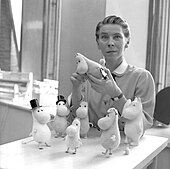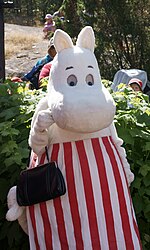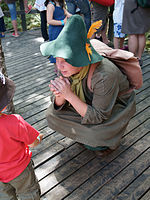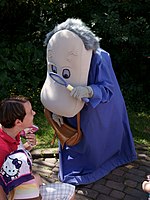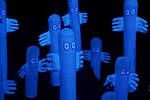Moomins
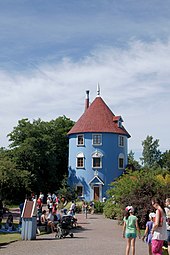
The Moomins are hippopotamus-like troll creatures invented by the Finnish-Swedish writer Tove Jansson . You live in the idyllic Moomin Valley somewhere in Finland. The Moomins and Snorks have an estimated height of 50 cm, they have short fur, a bushy tail and are good swimmers and divers as well as boat operators.
The original Moomin stories - books, picture books and comics - have seen numerous adaptations, for example in cartoon and puppet show series and in radio plays . The Moomin books enjoy great popularity worldwide, have been translated into more than 30 languages and secure Tove Jansson a place among the most famous Scandinavian writers.
Moomin works
Books
Tove Jansson wrote and illustrated nine Moomin books between 1945 and 1970:
- Moomin's long journey ( Småtrollen och den stora översvämningen , 1945)
- Komet im Mumintal ( Kometen kommer , 1946)
- The Moomins. A funny company ( Trollkarlens hatt , 1948)
- Moominfater's wild youth ( Moominpappans memoarer , 1950)
- Storm in the Moomin Valley ( Farlig midsommar , 1954)
- Winter in the Mumintal ( Trollvinter , 1957)
- Stories from the Moomin Valley ( Det osynliga barnet , 1963)
- Moomin's wondrous island adventures ( Pappan och havet , 1965)
- Autumn in the Mumintal ( Sent i november , 1970)
The first five of these can be considered children's books; happy adventure motifs determine the actions. A common motive is surviving external threats. The tolerant interaction between the characters is also relevant for adults. With the sixth volume, the series turns into psychologically observational drama, with the plot being shifted more and more into the interior of the characters. Issues are now internal compulsions, loneliness and aging. The seventh book is formally out of the ordinary, as it does not offer a continuous plot, but rather consists of short, self-contained narratives - a form that was to be formative for the subsequent adult books by Tove Jansson.
The illustrative development runs parallel to this literary development: while the drawings for the first volumes are still characterized by watercolors, the middle books are dominated by a black-and-white style, which is characterized on the one hand by closed lines and on the other by a hatching technique reminiscent of Edward Gorey . In the last three books the drawing line gives up its closedness and becomes more and more fleeting and sketchy.
In the German-speaking world, the Moomin books became known from the 1950s. The order of publication did not coincide with that of the originals. In addition, the titles were not translated, but completely changed; this gave the series an outward seriality that it actually does not have in the original.
All Moomin books are currently available from Arena Verlag .
picture books
In addition to the Moomin novels and stories, Tove Jansson also published four picture books:
- Moomin, how will it go on? ( Hur gick det sen?, 1952)
- Who comforts Toffel? ( Vem ska trösta Knyttet?, 1960)
- The miraculous journey into the Moomin Valley ( Den farliga Resan , 1977)
- The villain in the Moomin house ( Skurken i Muminhuset , 1980)
The first three books focus on the graphic design (the first even integrates differently shaped recesses in the design of the pages), while the fourth is a photo book set in a large Moominhaus model.
comics
Between 1954 and 1957, Tove Jansson drew a Moomin comic strip that appeared in daily three-picture strips for the English newspaper Evening News . Some of the motifs were taken from her Moomin books - some motifs appear in later books - and some from the current real world. In addition, the entertaining element is clearly in the foreground. As a result, the comics are not completely in tune with the cosmos of the Moomin books.
The growing burden of drawing comics by appointment prompted Tove Jansson to hand the series over to her brother Lars after 21 episodes , who continued it until the 73rd episode (1975).
Moomin comics appeared in many daily newspapers in the German-speaking area in the 1950s and 1960s, and later also in youth magazines ( Rasselbande , Flhkiste ) and magazines. At the beginning of the 1980s, Bastei-Verlag brought out a series of booklets in which the comics were, however, partially shortened and the text changed.
A new complete edition in English was started in 2006 by Drawn and Quarterly . A German edition of this edition has been published by Reprodukt since 2009 .
In Finland, new Moomin comics have been designed by other cartoonists since the 1990s, but most of them are based on motifs from Moomin books.
characters
The following beings populate the Moomin cosmos:
- Moomin: childlike, longing and imaginative
- Moominpapa: with a top hat, both bourgeois-settled and lousy-adventurous
- Moominmama: with apron and handbag, unshakably loving and tolerant
- Schnüferl / Sniff: naive and clumsy, fearful but also curious, a weasel-like troll.
- Snorkfräulein: Moomin's friend and admirer. Their relationship is not always clear: sometimes she falls in love with others, but always turns to Moomin before things get too serious; But she is no stranger to jealousy.
- Snork, the brother of the Snorkfräuleins: He is an inventor, z. B. from airships, for this reason often takes himself seriously, is impatient and organizes with passion. Only in the early books.
- Kleine My / Klein Mü: Mymla's smallest and youngest daughter, whose birth is mentioned in the book “Moominvaters wild-moved youth”. Autonomous and disrespectful, she usually sees through her counterpart faster than he is comfortable with. She wears a red dress and sturdy shoes.
- Daughter of Mymla: the big sister of the little ones My. The mother of the two only appears in "Moominfather's wildly moved youth".
- Schnupferich / Snufkin / Mumrik / Schnüffel: admired, freedom-loving and authority-rejecting friend of Moomin. From "Komet im Mumintal" on. Another human-like troll who wears baggy green clothes, a hat with a brown feather and a yellow scarf.
- Filifjonka: a whole species of mostly female individuals, lean and tall and with a pointed snout. One specimen lives with her three children near the Moomin House. She is very concerned about the welfare and upbringing of her children.
- Hemule: are a whole species of mostly correct-compulsive individuals: stamp collectors, botanists, park rangers, police inspectors. Whatever they do, they do it with the greatest dedication and conscientiousness. Look similar to Moomins, but are much slimmer.
- Hatifnatten: small, ghost-like, asparagus-like creatures that appear in large numbers where there is a threat of disaster, e.g. B. a big thunderstorm. They look for the electrical charge of lightning and are then charged themselves so that you can get a blow from them. They are mute and communicate with one another in an unclear way.
- Bisam: a philosopher who starts from the pointlessness of things and reads Oswald Spengler . He appears in “Komet in Moumintal” and “Eine drollige Gesellschaft” and lives with the Moomins in the house until it becomes too disrespectful there.
- Morra (in Swedish Mårran , from Swedish morra , "murmur, growl"): a cold and lonely creature that appears every now and then in the Moomin Valley. She freezes whatever she touches (the floor she sits on for longer freezes as hard as a stone) and rarely speaks (e.g. in "The Moomins. A funny company"). The Moomin Valley residents are afraid of her. It is black, the body consists only of the head, which merges seamlessly into a sheet-like body, and two arms with paws. Only in "Winter in the Moomin Valley", where Moomin and Klein My experience the mid-winter festival, a little sympathy for Morra is awakened.
- The ant lion, which lives buried in the sand, lures the ants in a funnel in the sand in order to eat them, but unfortunately also almost the Moominmother.
- Tooticki: a smart woman, and a good friend of the family. She has a boyish look with her blue hat and red-striped shirt and is able to solve all kinds of problems in a sensible and practical way. She is one of the few in the Moomin cosmos who does not go into hibernation. Instead, Tooticki spends the winter in the cozy sauna building of the Moomin House. Tooticki's character and name was created by Tove Jansson after her partner Tuulikki Pietilä.
- The magician / goblin: has an elongated, white face with red eyes, wears a black coat with red lining and rides a black panther through the air, must always leave before sunrise. Is always on the lookout for rubies, especially the royal ruby.
- Tofslan and Vifslan: two little creatures with trunk-like noses, clad in little coats. You visit the Moomins and travel with a suitcase containing a large ruby.
Further processing of the Moomin material
Film adaptations
The Moomins' stories have been filmed several times. In addition to the recordings of the Augsburger Puppenkiste , the Polish-Austrian puppet animation series Die Mumins from the Se-ma-for -Studios is very well known (1978–1982); In the German version, all the characters were dubbed by Hans Clarin . The uncut version was released on 7 DVDs in the 2000s.
In the years 1969 to 1972 two anime series with 65 and 52 episodes were filmed, which Tove Jansson did not like very much because they did not faithfully implement the message of the original series. In the years 1990 to 1992 two further anime series (78 and 26 episodes) including the short film Komet im Moominland were produced, which was shown together with two other films.
In 1973 a Christmas series, Mumindalen , was produced in Sweden with the Moomins . This was broadcast as a 24-part television advent calendar . The Moomins are portrayed by actors in costume. The series was not dubbed in German.
In 2014, the Finnish-French cartoon Muumit Rivieralla ( Moomins on the Riviera ) was released. Directed by Xavier Picard and Hanna Hemilä.
On February 1, 2019, the first episode of the Finnish-British animated series Moominvalley aired in Great Britain . It was first broadcast in Finland on February 25, 2019 on Yle TV2 under the title Muumilaakso . On November 25, 2020, the series ran on KiKA under the title Mumintal for the first time on German television.
marketing
There has been a Moomin Museum in Tampere since 1987 . A Moomin theme park ( Moomin World ) is located in Naantali . Many Finnish children are already growing up in a Moomin world: the creatures from Jansson's stories adorn considerable parts of Finnish children's products. The Finnish design company Arabia has made the tableware set with Moomin motifs an export hit. The Finnish Post issues Moomin postage stamps every few years.
music
The Swedish folk rock prog band Ritual process the stuff freely on their album The Hemulic Voluntary Band . The "hemulian volunteer band" from the Moominworld is themed in the title song as well as in the songs A Dangerous Journey and Seasong For The Moominpappa .
The Israeli composer Chaya Czernowin takes up the Moomin material in her work Pilgerfahrten for speakers, boys' choir and instrumental ensemble and combines it with texts by the poet Stefan George . The work was premiered in 2007 by the Dresden Kreuzchor .
In Russia, the rock band Mumi Troll named itself after the most famous figure of Tove Jansson.
Web links
- Virtual Moomin Research Center
- Mareike Jendis: Moomin's wondrous German adventures . To the reception of Tove Janson's Moomin books. (PDF, dissertation 2001).
- The mummin valley of the Tampere Art Museum in Finland
- The Moomin cartoon series
- Original Moomin page from Oy Moomin Characters Ltd with lots of information about the Moomin and the author (English, Swedish and Finnish)
Individual evidence
- ↑ finnland.de. Viewed October 24, 2010
- ↑ Mumindalen.Viewed April 22, 2021
